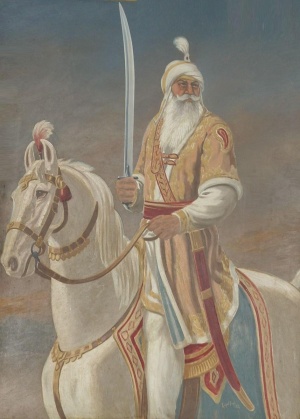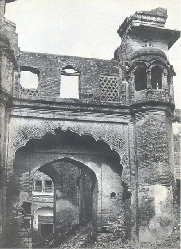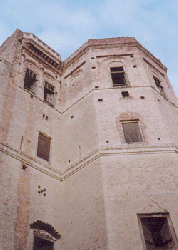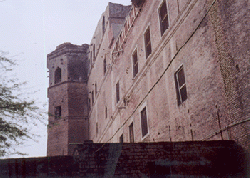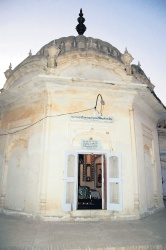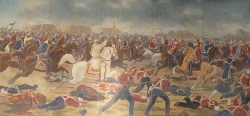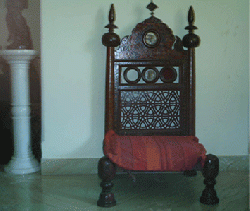Sardar Sham Singh Attari: Difference between revisions
No edit summary |
m (→External Links) |
||
| (37 intermediate revisions by 5 users not shown) | |||
| Line 1: | Line 1: | ||
[[Image:Sardar Sham Singh Attarivala (d. 1846).jpg|thumb|300px|right|Sardar Sham Singh Attarivala (d. 1846).jpg]] | |||
'''Sardar Sham Singh Attari''' (Circa 1785-1846), a Sikh general in the Sikh army of Lahore Darbar, belonged to a Jatt family of Sidhu Clan. was the only son of Sardar Nihal Singh Attari (d. 1817), and grandson of Sardar Gaur Singh Attari (d. 1763), The first in line to Convert to Sikhism in the early days of Sikh political ascendancy and joined the Jatha or band of Sardar Gurbakhsh Singh of Roranvala. He soon established his, protection over an area around Attari, a village he had founded some 16 miles west from the holy city of [[Amritsar]]. His son, Nihal Singh Attari, was known for his martial prowess and for his personal loyalty to [[Maharaja Ranjit Singh]]. Nihal Singh's son, Sham Singh Attari, entered the service of the Maharaja in 1817 and, in 1818, took part in the military campaigns of [[Peshawar]], [[Attock]] and [[Multan]]. He also fought in [[Kashmir]] in 1819. He led Sikh forces against Sayyid Ahmad of Bareilly who had during the years 1826-31 carried on in the trans-Indus region a relentless crusade against the Sikhs. Sayyid Ahmad was overcome and killed on 6 May 1831, along with his chief lieutenant, Muhammad Ismail. | |||
== Ancestors == | |||
Dhira, a Jatt of Sidhu Clan, was the first known Ancestor of Sham Singh Attari, Dhira Jatt, who migrated from Jaisalmer region of Rajasthan, to present day Mehraj village, In present day Bathinda District of the Malva region of Punjab. | |||
In 1735, the Sidhu family split up, Some members settling, at the village of Indgarh, near Jagraon, while Kahn Chand Sidhu with 25 horseman, left for the Majha, crossing the Sutlej river. He had two sons, Gaur Singh one of them, was a follower of a Local Ascetic named Muldas. He later converted to Sikhism, during the early days of Sikh political ascendancy, and joined the Jatha or band of Sardar Gurbakhsh Singh Roranvala. Gauhar Singh had many Sons, one of them was Sardar Nihal Singh Attari, who served the Bhangi Misl, but later joined Maharaja Ranjit Singh, and continued to serve him upto 1817 the year of his death. | |||
==Life of Sham Singh Attari== | |||
At the Darbar, Sham Singh Atarivala acted on occasions as Chief of Protocol. In that capacity, he received [[Sir Alexander Burnes]] when he had in July 1831 brought from the King William IV of England, presents of horses and a carriage for the Maharaja of Punjab. He was charged with protocol duties at the Ropar meeting in October 1831 between Lord William Bentinck, the Governor General of India, and Maharaja Ranjit Singh, as also at the Firozpur meeting in November 1838 between the Maharaja and Lord Auckland. Sham Singh's influence at the court was further enhanced by the marriage of his daughter, Maharani Nanaki kaur, to Maharaja Ranjit Singh's grandson, Prince [[Nau Nihal Singh]]. Sham Singh Attari, also was educated In different languages like Gurmukhi, Persian. | |||
In the cold season of 1844, Sham Singh led a punitive expedition to Jammu against [[Raja Gulab Singh]] and secured the surrender of Jasrota. His troops led the insurrection against Dogra dominance in [[Lahore]] Darbar which ended in the assassination of [[Hira Singh]] and his favourite, Pandit Jalla. For his influence over the [[Khalsa]] army and for his qualitites of courage and forthrightness, Sham Singh was nominated to the council of regency set up by [[Maharani Jind Kaur]] on 22 December 1844 for the minor sovereign [[Maharaja Duleep Singh]]. In March 1845, Sham Singh led another punitive expedition against Gulab Singh of Jammu who had refused to surrender to the Lahore government the treasure of [[Hira Singh]] amounting to 35,00,000 rupees which he had carted away from [[Jasrota]] to [[Jammu]]. The army under Sham Singh reached within 10 km of Jammu and obtained from [[Gulab Singh]] the undertaking to indemnify the arrears of the tribute, pay nazaranas and return to the Lahore government Hira Singh's treasure. | |||
At the outbreak of the first Anglo-Sikh war, Sham Singh was at Kakrala, south of the Sikh frontier, for the wedding of his second son, Sardar Kahn Singh Attari. As he heard the news, he rushed back to the Punjab Province. The defeat of the Sikh forces at [[Ferozeshah]] led the Queen Mother, Maharani Jind Kaur, to summon him from Attari. Sham Singh immediately repaired to Lahore. He chided the commanders, Misr [[Raja Tej Singh]] and Misr Lal Singh, who had fled the field, and himself crossed the Sutlej swearing an oath on the [[Guru Granth Sahib]], the holy Sikh Scriptures, that he would lay down his life rather than return in defeat. | |||
The battle was joined at Sabraon on 10 February 1846. 60 year old Sham Singh Attari, Dressed in white and riding his white steed, the White bearded Sardar Sham Singh moved from column to column calling upon his men to fight to the last, to save an Imperial power, from the British East India Company. As the battle was in a critical stage, Misr Tej Singh fled across the Sutlej and sank a part of the bridge of boats after him. Sham Singh, far from disheartened by this, rushed into the thick of the battle. He made a desperate charge along with his fifty men against the advancing enemy. Within minutes he was overpowered and he fell to the ground dead. In the evening as the battle was over, The Sikh soldiers swam from across the river to recover the body. On 12 February 1846, Sham Singh was cremated outside his village. A samadh raised on the site now honours his memory, Built near the Samadhis of his family, and near the Samadh of family elder Mai Dasi. His death marked, the weakening of the Sikh Empire, And with Maharani Jind Kaur, being forcibly banished, away from the palaces of Lahore, In 1847, by the British and three years later 1849, The falling and crumbling Sikh Kingdom of Punjab, was annexed to the British Empire. | |||
==Photo Gallery of Attari Haveli of Sardar Sham Singh Attarivala== | |||
<gallery caption="Picture Gallery" widths="250px" heights="250px" perrow="3"> | |||
File:Darwaza, to Haveli of Sham Singh Attari..gif | |||
File:Haveli of Sham Singh Attari, At village Attari..gif | |||
File:Haveli Walls of Sham Singh Attari..gif | |||
File:Crumbling Haveli of Sham Singh Attari.jpg | |||
File:Samadhi Shaheed Sham Singh Attari, at village Attari, District Amritsar (Punjab)..jpg | |||
File:Battle of Sabraon, where the brave warrior, Sham Singh, met his end..JPG | |||
File:Peerah (Low Chair), Upon Which the newly married girl would be made to sit at Attari Haveli.gif | |||
</gallery> | |||
==References== | |||
#Suri, Sohan Lal, `Umdat ut-Twarikh. Lahore, 1885-89 | |||
#Ganda Singh, Sardar Sham Singh Atarivala. Amritsar, 1942 | |||
#Griffin, Lepel and C.F. Massy, Chiefs and Families of Note in the Punjab. Lahore, 1909 | |||
#Harbans Singh, The Heritage of the Sikhs. Delhi, 1983 | |||
#Khushwant Singh, A History of the Sikhs, vol. II. Princeton, 1966 | |||
== External Links == | |||
* [http://tuhitu.blogspot.com/2012/02/sham-singh-attari.html Sham Singh Attari] | |||
* [https://archive.org/details/TheSikhGenerals Sham Singh Ji Attari and other Sikh Generals] | |||
[[Category:Great Sikh Warriors]] | [[Category:Great Sikh Warriors]] | ||
Latest revision as of 04:06, 2 May 2015
Sardar Sham Singh Attari (Circa 1785-1846), a Sikh general in the Sikh army of Lahore Darbar, belonged to a Jatt family of Sidhu Clan. was the only son of Sardar Nihal Singh Attari (d. 1817), and grandson of Sardar Gaur Singh Attari (d. 1763), The first in line to Convert to Sikhism in the early days of Sikh political ascendancy and joined the Jatha or band of Sardar Gurbakhsh Singh of Roranvala. He soon established his, protection over an area around Attari, a village he had founded some 16 miles west from the holy city of Amritsar. His son, Nihal Singh Attari, was known for his martial prowess and for his personal loyalty to Maharaja Ranjit Singh. Nihal Singh's son, Sham Singh Attari, entered the service of the Maharaja in 1817 and, in 1818, took part in the military campaigns of Peshawar, Attock and Multan. He also fought in Kashmir in 1819. He led Sikh forces against Sayyid Ahmad of Bareilly who had during the years 1826-31 carried on in the trans-Indus region a relentless crusade against the Sikhs. Sayyid Ahmad was overcome and killed on 6 May 1831, along with his chief lieutenant, Muhammad Ismail.
Ancestors
Dhira, a Jatt of Sidhu Clan, was the first known Ancestor of Sham Singh Attari, Dhira Jatt, who migrated from Jaisalmer region of Rajasthan, to present day Mehraj village, In present day Bathinda District of the Malva region of Punjab.
In 1735, the Sidhu family split up, Some members settling, at the village of Indgarh, near Jagraon, while Kahn Chand Sidhu with 25 horseman, left for the Majha, crossing the Sutlej river. He had two sons, Gaur Singh one of them, was a follower of a Local Ascetic named Muldas. He later converted to Sikhism, during the early days of Sikh political ascendancy, and joined the Jatha or band of Sardar Gurbakhsh Singh Roranvala. Gauhar Singh had many Sons, one of them was Sardar Nihal Singh Attari, who served the Bhangi Misl, but later joined Maharaja Ranjit Singh, and continued to serve him upto 1817 the year of his death.
Life of Sham Singh Attari
At the Darbar, Sham Singh Atarivala acted on occasions as Chief of Protocol. In that capacity, he received Sir Alexander Burnes when he had in July 1831 brought from the King William IV of England, presents of horses and a carriage for the Maharaja of Punjab. He was charged with protocol duties at the Ropar meeting in October 1831 between Lord William Bentinck, the Governor General of India, and Maharaja Ranjit Singh, as also at the Firozpur meeting in November 1838 between the Maharaja and Lord Auckland. Sham Singh's influence at the court was further enhanced by the marriage of his daughter, Maharani Nanaki kaur, to Maharaja Ranjit Singh's grandson, Prince Nau Nihal Singh. Sham Singh Attari, also was educated In different languages like Gurmukhi, Persian.
In the cold season of 1844, Sham Singh led a punitive expedition to Jammu against Raja Gulab Singh and secured the surrender of Jasrota. His troops led the insurrection against Dogra dominance in Lahore Darbar which ended in the assassination of Hira Singh and his favourite, Pandit Jalla. For his influence over the Khalsa army and for his qualitites of courage and forthrightness, Sham Singh was nominated to the council of regency set up by Maharani Jind Kaur on 22 December 1844 for the minor sovereign Maharaja Duleep Singh. In March 1845, Sham Singh led another punitive expedition against Gulab Singh of Jammu who had refused to surrender to the Lahore government the treasure of Hira Singh amounting to 35,00,000 rupees which he had carted away from Jasrota to Jammu. The army under Sham Singh reached within 10 km of Jammu and obtained from Gulab Singh the undertaking to indemnify the arrears of the tribute, pay nazaranas and return to the Lahore government Hira Singh's treasure.
At the outbreak of the first Anglo-Sikh war, Sham Singh was at Kakrala, south of the Sikh frontier, for the wedding of his second son, Sardar Kahn Singh Attari. As he heard the news, he rushed back to the Punjab Province. The defeat of the Sikh forces at Ferozeshah led the Queen Mother, Maharani Jind Kaur, to summon him from Attari. Sham Singh immediately repaired to Lahore. He chided the commanders, Misr Raja Tej Singh and Misr Lal Singh, who had fled the field, and himself crossed the Sutlej swearing an oath on the Guru Granth Sahib, the holy Sikh Scriptures, that he would lay down his life rather than return in defeat.
The battle was joined at Sabraon on 10 February 1846. 60 year old Sham Singh Attari, Dressed in white and riding his white steed, the White bearded Sardar Sham Singh moved from column to column calling upon his men to fight to the last, to save an Imperial power, from the British East India Company. As the battle was in a critical stage, Misr Tej Singh fled across the Sutlej and sank a part of the bridge of boats after him. Sham Singh, far from disheartened by this, rushed into the thick of the battle. He made a desperate charge along with his fifty men against the advancing enemy. Within minutes he was overpowered and he fell to the ground dead. In the evening as the battle was over, The Sikh soldiers swam from across the river to recover the body. On 12 February 1846, Sham Singh was cremated outside his village. A samadh raised on the site now honours his memory, Built near the Samadhis of his family, and near the Samadh of family elder Mai Dasi. His death marked, the weakening of the Sikh Empire, And with Maharani Jind Kaur, being forcibly banished, away from the palaces of Lahore, In 1847, by the British and three years later 1849, The falling and crumbling Sikh Kingdom of Punjab, was annexed to the British Empire.
Photo Gallery of Attari Haveli of Sardar Sham Singh Attarivala
- Picture Gallery
References
- Suri, Sohan Lal, `Umdat ut-Twarikh. Lahore, 1885-89
- Ganda Singh, Sardar Sham Singh Atarivala. Amritsar, 1942
- Griffin, Lepel and C.F. Massy, Chiefs and Families of Note in the Punjab. Lahore, 1909
- Harbans Singh, The Heritage of the Sikhs. Delhi, 1983
- Khushwant Singh, A History of the Sikhs, vol. II. Princeton, 1966
